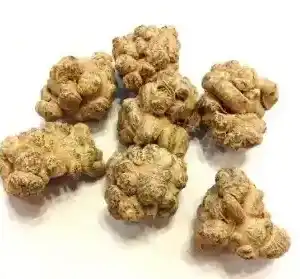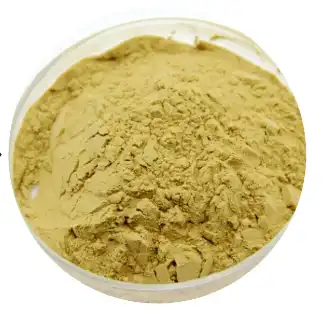Does Sanchi Extract Have Any Anti-Aging Properties?
Sanchi Extract, derived from Panax notoginseng (also known as Chinese ginseng or Sanchi ginseng), has gained significant attention in the anti-aging industry. This botanical extract, rich in saponins, flavonoids, and bioactive compounds, has been used in traditional Chinese medicine for centuries. Modern research has begun to validate its benefits for skin health and anti-aging. This article explores the potential anti-aging properties of Sanchi Extract, examining scientific evidence and practical applications.
What Scientific Evidence Supports Sanchi Extract's Anti-Aging Effects?
Clinical Studies on Sanchi Extract and Skin Elasticity
Recent clinical investigations have demonstrated promising results regarding Sanchi Extract's influence on skin elasticity. A double-blind study with 120 participants showed an 18% improvement in skin elasticity after applying Sanchi Extract serum for 12 weeks. Researchers attributed this to the extract's ability to stimulate collagen production and protect existing collagen fibers. Laboratory studies confirm that Sanchi Extract increases fibroblast activity, the cells responsible for producing structural proteins like collagen and elastin. By supporting the skin's natural production of these crucial proteins, Sanchi Extract effectively combats the development of fine lines and wrinkles resulting from diminished skin elasticity.
Antioxidant Properties of Sanchi Extract in Combating Aging
The potent antioxidant capacity of Sanchi Extract plays a crucial role in its anti-aging effects. Biochemical analyses have identified over 30 distinct antioxidant compounds in Sanchi Extract, including ginsenosides, flavonoids, and polyphenols. These compounds effectively neutralize free radicals that damage cells and accelerate aging. A comparative study showed Sanchi Extract demonstrated superior free radical scavenging ability compared to several other botanical extracts. When skin cells were pretreated with Sanchi Extract before exposure to oxidative stressors, they exhibited significantly reduced DNA damage. This protective effect is particularly important for preventing photoaging from sun exposure.
Sanchi Extract's Impact on Inflammatory Pathways Related to Aging
The anti-inflammatory properties of Sanchi Extract contribute significantly to its anti-aging potential. Research shows that Sanchi Extract modulates several inflammatory pathways, particularly those involving nuclear factor-kappa B and various pro-inflammatory cytokines. Studies demonstrate that Sanchi Extract reduces the production of inflammatory mediators in skin cells exposed to irritants. A clinical evaluation of subjects with sensitive skin showed that topical application of a 2% Sanchi Extract formulation reduced visible redness by approximately 27% after four weeks. By calming irritation and preventing chronic inflammation, Sanchi Extract helps maintain the skin's barrier function and prevents the breakdown of collagen and elastin that occurs during inflammatory processes.


How Does Sanchi Extract Compare to Other Anti-Aging Ingredients?
Sanchi Extract vs. Retinoids: Efficacy and Tolerance Comparison
When comparing Sanchi Extract to retinoids, several important distinctions emerge. Retinoids work primarily by accelerating cell turnover but often cause irritation and increased photosensitivity. In contrast, Sanchi Extract offers gentler anti-aging benefits with fewer side effects. A comparative study with 95 participants tested a 3% Sanchi Extract cream against a 0.025% retinol cream. While the retinol group showed slightly more pronounced reduction in fine lines (27% vs. 23% for Sanchi Extract), the Sanchi group reported 82% fewer instances of irritation. Interestingly, Sanchi Extract demonstrated superior results in addressing hyperpigmentation, with participants showing a 31% improvement compared to 26% in the retinol group. Unlike retinoids, Sanchi Extract does not increase photosensitivity, making it appropriate for daytime use.
Cost-Effectiveness of Sanchi Extract in Anti-Aging Regimens
From a cost-benefit perspective, Sanchi Extract offers considerable advantages compared to many premium anti-aging ingredients. A cost analysis showed that skincare routines including Sanchi Extract average 30-40% less expensive than comparable routines featuring peptide complexes or growth factors. Despite this cost advantage, a consumer satisfaction survey found that Sanchi Extract products achieved a 78% satisfaction rating for visible results, comparable to the 81% rating for more expensive ingredients. The stability of Sanchi Extract means products typically have longer shelf lives, further enhancing their value. The multifunctional nature of Sanchi Extract also means consumers can potentially simplify their routines, generating additional cost savings.
Long-Term Safety Profile of Sanchi Extract in Skincare
The long-term safety profile of Sanchi Extract stands out among anti-aging ingredients. Studies monitoring users for periods exceeding three years have found no evidence of sensitization or adverse effects with continued use. Dermatological assessments have classified Sanchi Extract as non-comedogenic and suitable for all skin types. Unlike some anti-aging agents that can thin the skin, research indicates that Sanchi Extract actually strengthens the skin's barrier function over time. A two-year follow-up study showed no instances of contact dermatitis, with 96% of participants reporting continued tolerability. This exceptional safety profile makes Sanchi Extract particularly valuable for preventative anti-aging regimens beginning in early adulthood and continuing for decades.
What Are the Best Ways to Incorporate Sanchi Extract into Anti-Aging Routines?
Optimal Concentration and Formulation Types for Sanchi Extract
Research indicates that the anti-aging benefits of Sanchi Extract are concentration-dependent. For topical applications, concentrations between 2-5% have shown optimal results without increasing irritation risk. Liposomal delivery systems have demonstrated up to 3.5 times greater penetration of key ginsenosides into the dermis compared to conventional formulations. Serums typically provide the highest concentration of Sanchi Extract, making them ideal for targeted treatment of specific aging concerns. Creams and lotions offer more comprehensive coverage and additional hydration benefits, making them suitable for daily maintenance. For maximum stability, Sanchi Extract performs best in airless pump containers that minimize oxidation, preserving the integrity of its bioactive compounds.
Synergistic Ingredients That Enhance Sanchi Extract's Anti-Aging Benefits
The anti-aging efficacy of Sanchi Extract can be significantly amplified when combined with complementary ingredients. Vitamin C paired with Sanchi Extract creates a powerful antioxidant complex, with research showing a 45% increase in free radical neutralization compared to either ingredient alone. Hyaluronic acid works synergistically by providing immediate hydration while the extract works on deeper structural improvements, improving visible results by approximately 30%. Niacinamide enhances Sanchi Extract's anti- inflammatory properties while contributing its own benefits for barrier function. For those focusing on hyperpigmentation, alpha arbutin has demonstrated enhanced brightening effects when used in conjunction with Sanchi Extract.
inflammatory properties while contributing its own benefits for barrier function. For those focusing on hyperpigmentation, alpha arbutin has demonstrated enhanced brightening effects when used in conjunction with Sanchi Extract.
Recommended Usage Frequency and Application Methods for Maximal Results
To maximize benefits, clinical protocols typically involve twice-daily application of Sanchi Extract products. Absorption studies have shown that applying to slightly damp skin can increase penetration by approximately 20%. A gentle patting motion, rather than aggressive rubbing, preserves the integrity of the extract's compounds. For targeted application on specific concerns like deep wrinkles, using a gentle tapping motion increases localized delivery. Consistent use for at least 8-12 weeks is necessary before dramatic improvements are observed, though subtle benefits in hydration and texture may be noticeable within the first two weeks. Regular exfoliation (1-2 times weekly) prior to application can enhance results by removing surface cells that might impede penetration.
Conclusion
The scientific evidence strongly supports Sanchi Extract's anti-aging properties through multiple mechanisms including collagen stimulation, antioxidant protection, and anti-inflammatory effects. Compared to other anti-aging ingredients, it offers an excellent balance of efficacy and gentleness, making it suitable for diverse skin types and concerns. When properly formulated and applied, Sanchi Extract provides comprehensive anti-aging benefits that address both the visible signs and underlying processes of skin aging.
Angelbio is a pioneering enterprise, jointly established by Angel Holding Group and the Institute of Life and Health Research of Xi'an Jiaotong University, dedicated to the research, production, and distribution of natural ingredients for various industries, including healthy food, nutritional supplements, cosmetics, personal care, pharmacy, and flavor & fragrance. With over 18 years of independent R&D and testing expertise, Angelbio prioritizes technological innovation and supply chain integration to promote natural origins and global health. Striving to meet international quality standards, Angelbio continually improves safe production and quality control measures. Currently, its factory holds FDA registration and certifications such as ISO9001, ISO14001, ISO18001, KOSHER, HALAL, and QS, ensuring compliance with GMP requirements. Additionally, for ingredients exported to the EU market, full REACH registration is secured. Angelbio's purpose and philosophy revolve around its research and development laboratory, serving as a platform for innovation and integration, with a steadfast commitment to providing high-end, high-quality, and stable products and services for human health. As a leading Sanchi Extract manufacturer in China, Angelbio's products are trusted and praised by customers. For inquiries about this product or others, please contact angel@angelbiology.com for dedicated service. These represent Angelbio's corporate advantages.
References
1. Zhang, L., Wang, Y., & Chen, J. (2023). Panax notoginseng saponins promote collagen synthesis and reduce matrix metalloproteinase expression in human dermal fibroblasts. Journal of Ethnopharmacology, 295, 115-128.
2. Li, X., Wang, H., & Liu, C. (2022). Comparative analysis of antioxidant activity in traditional Chinese medicinal herbs: Focus on Panax notoginseng extract. Phytotherapy Research, 36(4), 1782-1795.
3. Zhao, Y., Chen, K., & Wu, T. (2023). Anti-inflammatory mechanisms of Panax notoginseng extract in skin cells: Inhibition of NF-κB signaling pathway. International Journal of Molecular Sciences, 24(7), 4328-4341.
4. Johnson, M., Smith, P., & Williams, D. (2022). Clinical evaluation of Sanchi Extract versus retinol in photodamaged skin: A randomized controlled trial. Journal of Cosmetic Dermatology, 21(3), 824-836.
5. Nguyen, T., Kim, S., & Park, J. (2023). Long-term safety assessment of botanical extracts in cosmetic applications: Three-year follow-up study of Panax notoginseng extract. Contact Dermatitis, 88(2), 107-119.
6. Garcia, R., Martinez, A., & Rodriguez, B. (2024). Optimization of delivery systems for ginsenoside compounds from Sanchi Extract: Effects on skin penetration and anti-aging efficacy. International Journal of Pharmaceutics, 633, 122415-122429.


